
109
Sè §ÆC BIÖT / 2024
Summary
To meet the needs of students and contribute to improving the quality and effectiveness of
education, the author has selected four test components to evaluate the learning outcomes in Aerobics
for students majoring in Physical Education. At the same time, the author has developed assessment
standards according to the 04 selected components. The results of theoretical verification have shown
that the developed standards are completely suitable for students majoring in Physical Education at
Bac Ninh Sports University.
Keywords: Standards, components, Physical Education, Physical Education, students.
(1)Master, (2)PhD, Bac Ninh Sposst University
Nguyen Thi Kim Nga(1); Nguyen Van Thach(2)
Nghiem Thi Giang(1); Nguyen Thi Huyen(1); Dam Danh Phuong(1)
INTRODUCTION
Despite being a relatively new addition to the
curriculum for Physical Education majors, the
Aerobics subject has gained significant attention
from school leaders at all levels and widespread
support from students. The program continues
to grow rapidly, and after graduating, students
have gone on to contribute to sports initiatives
across the country.
In recent years, the university’s student
admission process has undergone considerable
changes to reflect new training goals and
requirements. As Aerobics becomes an
increasingly prominent subject for Physical
Education students, it has become clear that
updated, more appropriate assessment standards
are necessary. Developing these standards for
evaluating Aerobics learning outcomes is now
an urgent priority at Bac Ninh Sports University.
This effort is key to improving both Aerobics
instruction’s effectiveness and the university’s
overall training quality.
RESEARCH METHODS
During the research process, the author has
deployed the following research methods:
Method of synthesizing and analyzing docu-
ments, interview method, pedagogical observa-
tion method, expert method, and statistical
method.
RESULTS AND DISCUSSION
1. Selecting the components to evaluate
learning Aerobics learning outcomes for
students majoring in Physical Education,
Bac Ninh Sports University
Through reviewing professional documents,
analyzing the subject's curriculum, and
engaging in direct discussions with managers,
experts, and lecturers from the Department of
Physical Education, we identified seven key
components for phase tests and three for the
final exam. According to the selection criteria,
only components with an agreement rate of 70%
or higher were chosen. The results showed:
● For the phase tests, 3 out of 7 components
met the selection criteria with an agreement rate
of 70% or more. These components are the
combination of Zumba dance (100%), the
combination of basic Yoga exercises (93.3%),
and the compilation of Zumba dance exercises
(100%).
● For the final exam, 1 out of 3 components
satisfied the selection criteria, with the Physical
Education lesson plan (5-7 minutes based on the
ress) receiving 100% agreement.
Those are the components we integrated to
develop standards to evaluate students’ learning
outcomes in Aerobics subject, Physical
Education major, Bac Ninh Sports University.
DEVELOPING EVALUATION STANDARDS FOR LEARNING OUTCOMES
IN AEROBICS FOR STUDENTS MAJORING IN PHYSICAL EDUCATION
AT BAC NINH SPORTS UNIVERSITY

p-ISSN 1859-4417 e-ISSN 3030-4822
110
Table 1. Assessment Standards for Evaluating Learning Outcomes in the Aerobics Sub-
ject for Physical Education Majors at Bac Ninh Sports University
No. Components Evaluation standards Scale
(point)
Phrase test
1
Practice
- Combination
of Zumba
dance
exercises
- Combination
of basic
Yoga
Test structure: Ensure 3 parts in a test: warm-up, per-
form, finish 5
Ensure logic quality in the whole test.
Music: appropriate to the content and requirements of
the exercise (for every 10 seconds too long or too short,
1 point is deducted).
15
Execution: whether the performance is synchronized
or unsynchronized.
50
Note:
- Minor error (unsynchronized, off-beat): Deduct 1–
20% of points (equivalent to 1–2 students making
errors during 1–20% of the performance).
- Moderate error: Deduct 21–50% of points (equivalent
to 3–5 students making errors, being unsynchronized,
not knowing the routine, or off-beat).
- Major error: Failure to perform the required routine
results in a 100% deduction (100% of students standing
still without performing for more than 30 seconds).
Value and execution technique: amplitude, precision,
level, and aesthetic quality of the movement. 10
Creativity in choreography: innovation in the approach
to choreography, value of the choreographed
movements, methods and tools used, handling of
formations, and the composition of the test.
10
Costumes: appropriate for the content of the test,
consistent in color, and professionally suitable. 5
Expression: during the performance (cheerful facial
expressions, emotional interaction, and connection
between group members).
5
Total 100
Theory
C o m p i l e
Zumba dance
exercise
Correct procedure 5
Conceptual creativity 5
Artistic quality 5
Logical arrangement of participants with appropriate spacing 10
Formation changes and movements in sync with the music 50
Selection of suitable background music 20
Choreography is presented clearly and neatly 5
Total 100

111
Sè §ÆC BIÖT / 2024
2. developing standards to evaluate
student’s learning outcomes in Aerobics
subject, Physical Education major, Bac Ninh
Sports University
To develop standards for evaluating student
learning outcomes in the Aerobics subject for
Physical Education majors at Bac Ninh Sports
University, we relied on several key sources: the
Aerobics curriculum, student professional
qualifications, recent final exam results of
Physical Education students, and interviews
with teachers and experts in the field. The
results are presented in Table 1.
Using the developed standards, we
conducted theoretical verification through
interviews with 30 experts and experienced
No. Components Evaluation standards Scale
(point)
Final test
2Practice
Preparing a
Physical
Education
lesson plan
(5 to 7
minutes)
based on
the
results of a
draw"
Test structure: Ensure 3 parts in a test: warm-up, perform,
finish 5
Ensure logic quality in the whole test.
Music: appropriate to the content and requirements of the
exercise (for every 10 seconds too long or too short, 1 point
is deducted).
15
Execution: whether the performance is synchronized or
unsynchronized.
50
Note:
- Minor error (unsynchronized, off-beat): Deduct 1–20% of
points (equivalent to 1–2 students making errors during 1–
20% of the performance).
- Moderate error: Deduct 21–50% of points (equivalent to
3–5 students making errors, being unsynchronized, not
knowing the routine, or off-beat).
- Major error: Failure to perform the required routine results
in a 100% deduction (100% of students standing still without
performing for more than 30 seconds).
Value and execution technique: amplitude, precision, level,
and aesthetic quality of the movement. 10
Creativity in choreography: innovation in the approach to
choreography, value of the choreographed movements,
methods and tools used, handling of formations, and the
composition of the test.
10
Costumes: appropriate for the content of the test, consistent
in color, and professionally suitable. 5
Expression: during the performance (cheerful facial
expressions, emotional interaction, and connection between
group members).
5
Total 100

p-ISSN 1859-4417 e-ISSN 3030-4822
112
lecturers currently teaching Physical Education
at universities across the country. The interviews
were assessed using a 5-point Likert scale,
ranging from "Not guaranteed" to "Very
guaranteed." The results showed that for the
phase tests, the components "Combination of
Zumba dance exercises" and "Combination of
basic Yoga exercises" scored 4.8 points, while
"Compiling Zumba dance exercises" scored 4.6
points. For the final exam, the component
"Preparing a Physical Education lesson plan (5
to 7 minutes) based on the results of a draw"
scored 4.5 points.
Overall, the standards introduced were rated
as "Very satisfactory" by the majority of experts
and lecturers, falling within the range of 4.2 to
5.0 points. These findings confirm that the
components and standards we developed are
feasible and effective in assessing learning
outcomes in Aerobics for Physical Education
majors at Bac Ninh Sports University.
CONCLUSION
The research identified four key components
for evaluating the learning outcomes in Aerobics
for Physical Education majors at Bac Ninh
Sports University. Based on these components,
specific criteria were developed to assess
student performance in this subject. Theoretical
testing confirmed that the developed criteria
meet the requirements for practical application.
REFERENCES
1. Vu Thanh Mai, Dinh Khanh Thu, Pham
Tuan Dung, Luu The Son, Nguyen Huu Hung,
Nguyen Van Hieu (2014), Aerobics Textbook,
Hanoi Physical Education Publishing House,
Hanoi.
2. Nguyen Toan and Pham Danh Ton (2000),
Theory and Methodology in Physical Education,
Hanoi Physical Education Publishing House,
Hanoi.
3. Bac Ninh Sports University - Department
of Physical Education (2015), Physical
Education Program for Physical Education-
majoring students in 2015, Bac Ninh Sports
University, Bac Ninh.
4. Nguyen Duc Van (2001), Statistical
methods in Physical Education and Sports,
Hanoi Physical Education Publishing House,
Hanoi.
(Received 12/8/2024, Reviewed 20/10/2024,
Accepted 28/11/2024
Main responsible: Nguyen Thi Kim Nga
Email: kimngabmtd@gmail.com)


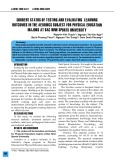
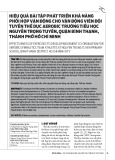
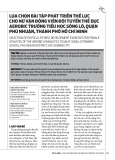
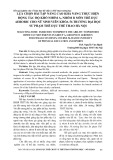
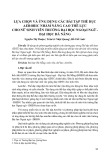



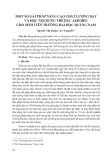




![Bài giảng Vovinam Việt Võ Đạo: Chương 2 - Các điều luật chung [Chi tiết]](https://cdn.tailieu.vn/images/document/thumbnail/2025/20251111/kimphuong1001/135x160/771762853254.jpg)










